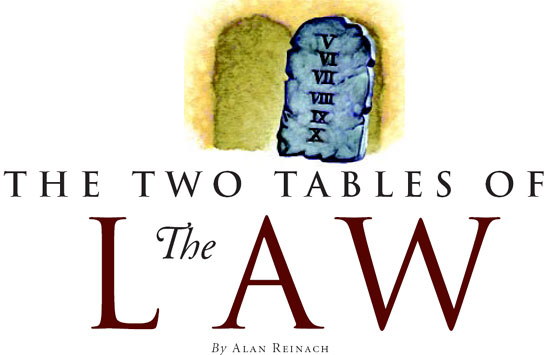The Two Tables of the Law
Alan J. Reinach May/June 2005

However, Puritan era "first table" laws against blasphemy, idolatry, and even Sunday laws fell into disfavor, not merely because of secular trends, but because in the Protestant conception, these obligations pertained not to the state but to God alone.
This division between the first and second tables of the law roughly corresponds to the distinction between legislating religion and morality. Under the First Amendment, the state has not jurisdiction to address essentially religious questions, such as when, where, how, or whom to worship. The first table of the law is out of bounds to the state. However, the second table of the law has always been the subject of civil law, despite the familiar adage that "you can't legislate morality." Actually, you can, and we do. The debate is never really about whether to legislate morality, but to what extent and from what source.
Under the American constitutional system, the state has no charge to order public morality according to the second table of the ten-commandment law, but neither is the state compelled to reject the second table. It is entirely legitimate for Americans to invoke the commandments in public policy debate, so long as the distinction between the first and second tables is observed. The Constitution does not permit the state to arbitrate religious belief and practice or to promote specific religious ideas. This means that the same Ten Commandments that many Americans look to for the content of public morality may be subject to constitutional restrictions when it comes to state efforts to publicly display and honor them. Although many view restricting the display of the commandments as official disrespect, it is far better for government to maintain a strict "hands-off" policy with respect to religion than to open a Pandora's box of public promotion of religion.
____________
Alan J. Reinach serves as vice-president of the North American Religious Liberty Association West, which has published "Written in the Heart," a guide and poster regarding the Ten Commandments, available at www.religiousliberty.info.
________________________
Article Author: Alan J. Reinach
Alan J. Reinach is Executive Director of the Church State Council, the religious liberty educational and advocacy arm of the Pacific Union Conference of Seventh-day Adventists, representing five western states: Arizona, California, Hawaii, Nevada and Utah. His legal practice emphasizes First Amendment religious freedom cases, and religious accommodation cases under Title VII of the Civil Rights Act of 1964 and related state civil rights laws. Reinach is also a Seventh-day Adventist minister who speaks regularly on religious freedom topics, and is the host of a nationally syndicated weekly radio broadcast, “Freedom’s Ring.” He is the principal author and editor of Politics and Prophecy: The Battle for Religious Liberty and the Authentic Gospel, and a frequent contributor to Libertymagazine.